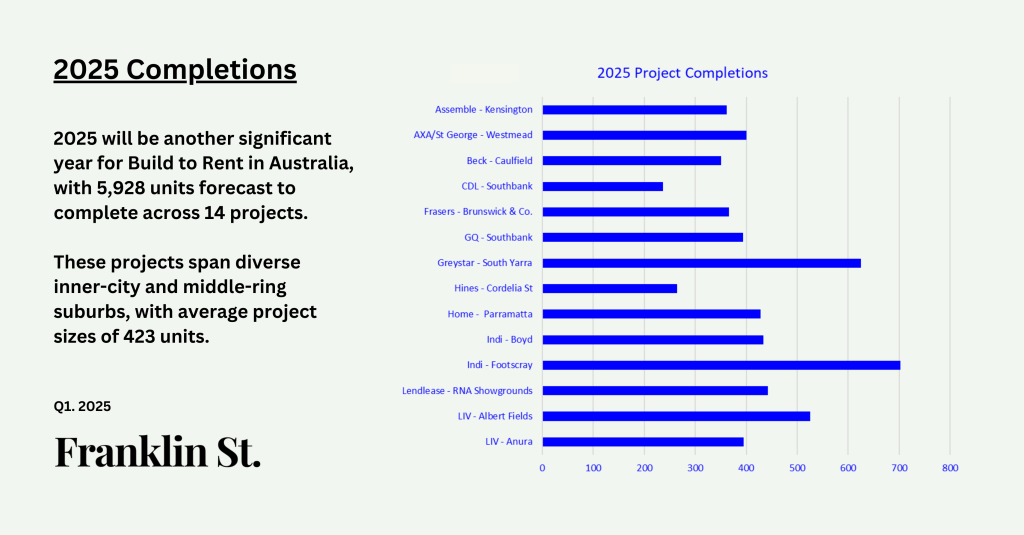The Australian Build to Rent Review: Q1 2025
Build to Rent reaches critical mass. Where to next?
Franklin St. is proud to release the latest edition of our flagship report: The Australian Build to Rent Review – Q1 2025. With over 65,000 units now tracked in our national database and 10,276 units operational across the country, the data confirms what we’ve long believed—Build to Rent (BTR) has become a core asset class in Australian real estate.
Despite ongoing challenges, the outlook is increasingly optimistic. Strong population growth, ultra-low vacancy rates, and stabilising construction costs have aligned to create a turning point for the sector. Below, we explore some of the key highlights from the report.
2024: A Landmark Year
The sector’s operational footprint doubled in 2024, with 4,878 units completed, taking the national total to over 10,000 units. These new completions brought with them a surge in leasing activity, particularly in Melbourne, which alone absorbed over 2,000 units in its CBD fringe.
Lease-up rates averaged 30–40 units per week, and average one-bedroom asking rents across new BTR projects hit $744 per week, with premium units reaching up to $940.
2025: Continued Momentum
Looking ahead, 5,928 units are forecast to complete in 2025, with delivery concentrated in Victoria (61%), followed by Queensland (25%) and New South Wales (14%). By the end of the year, we expect 16,204 units to be operational across Australia.
Importantly, 100% of the projects forecast to complete in 2025, 2026, and 2027 are already funded, providing certainty in what is otherwise a complex delivery environment.
National Pipeline Hits 65,575 Units
Australia’s BTR pipeline now includes 65,575 units, up 26% year-on-year. Yet, even if every project were built, BTR would still represent just 0.6% of all housing stock—a powerful reminder of both the scale of the housing shortfall and the opportunity ahead.
The spread of activity is also diversifying. Victoria remains the clear leader with 40% of the pipeline, but NSW (29%) and Queensland (23%) are catching up fast as geographic expansion continues.
Viability Improves as the BTR Equation Shifts
While construction costs and interest rates remain elevated, 2025 brings some relief. Inflation in build costs is slowing, and rents are rising faster than costs, helping feasibility metrics recalibrate. For many submarkets, BTR projects that didn’t pencil a year ago are now becoming viable.
As our BTR Equation charts show, project margins are improving, and we expect this to support a new wave of supply in late 2025 and 2026.
Maturation & Market Liquidity
Several key themes are defining this next phase of BTR:
- Consolidation: Expect early movers to begin recycling capital via asset sales.
- Valuation Benchmarks: Recent transactions are finally providing much-needed pricing clarity.
- New Formats: Growth is extending beyond inner-city towers to include mid-rise and single-family rental (SFR) formats.
- Shift in Risk Allocation: Developers are increasingly taking early-stage risk, while institutional capital is focusing on stabilised or de-risked assets.
Final Word
2025 marks a definitive shift. Build to Rent is no longer a concept—it’s an operating reality. And with clearer viability, deepening market liquidity, and strong leasing performance, the sector is becoming central to the future of housing in Australia.
Franklin St. is proud to play a leading role in this evolution. We’re more than just advisors—we’re specialists in unlocking capital, projects, and partnerships that shape the BTR landscape across the country.


